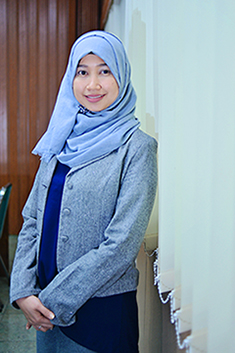Effect of Alpha-Lipoic Acid on the Characteristics and Physical Stability of NLC-Green Tea Extract
Downloads
Background: The addition of alpha-lipoic acid in Nanostructured Lipid Carrier-Green Tea Extract (NLC-GTE) has potential to increase effectiveness of anti-aging preparations. It happened because alpha-lipoic acid can increase stability and antioxidant activity. Objective: Comparing the physical characteristics and stability of NLC-GTE with or without alpha-lipoic acid. Methods: NLC-GTE manufactured using the High Shear Homogenization method. NLC-GTE was divided into two formulas, without the addition of alpha-lipoic acid for F1 and with the addition of alpha-lipoic acid for F2. The characteristics and physical stability were tested, including organoleptic, pH, particle size, and polydispersity index. Stability test was held using the thermal cycling method. Results: Based on characteristic test, it was found that F2 had larger particle size value than F1. The average particle size value of F1 is 313.9 ± 0.76 nm and 423.4 ± 0.75 nm for F2. The F1 and F2 preparations had a polydispersity index value below 0.3, so they were homogeneous. The average pH value of F1 is 5.998 ± 0.01, and F2 is 4.798 ± 0.004. The physical stability test showed a difference before and after the sixth day in particle size and pH, but it was still in the range, so it was safe. However, there was a separation in F1 after day 6. Conclusion: Based on the characteristics and physical stability tests, F1 (without alpha-lipoic acid) and F2 (with alpha-lipoic acid) had differences in particle size and pH. From the physical stability test, it can be concluded that F2 is more stable than F1.
Ahmad, Z & Damayanti. (2018). Penuaan Kulit Patofisiologi dan Manifestasi Klinis. Berkala Ilmu Kesehatan Kulit dan Kelamin-Periodical of Dermatology and Venereology; 30; 208-215. doi: 10.20473/bikk.V30.3.2018.208-215.
Anggowarsito, J. L. (2014). Aspek Fisiologi Penuaan Kulit. Jurnal Widya Medika; 2; 56-61. doi: 10.33508/jwm.v2i1.1652.
Bianchi, A, Valentina, T. & Santo, S. (2013). Photostability of Epigallocatechin-3- Gallate in Topical Formulation. Monographio Supplement Series: Sun Care. 8; 18-22.
Chen, J., Ning, W., Maria, L. G., Dianna, A., Jason, L., Colin, A. & Teresa, P. (2017). Development and Evaluation of Resveratrol, Vitamin E, and Epigallocatechin Gallate Loaded Lipid Nanoparticles for Skin Care Applications. European Journal of Pharmaceutics and Biopharmacetics; 117; 286-291. doi: 10.1016/j.ejpb.2017.04.008.
Cichewicz, A., Chelsea, P., Ashley, C., Martha A. H. & Luciana, B. L. (2013). Cutaneous Delivery of α-Tocopherol and Lipoic Acid Using Microemulsions: Influence of Composition and Charge. Journal of Pharmacy dan Pharmacology; 65; 817-826. doi: 10.1111/jphp.12045.
Frias, I., Ana, R. N., Marina, P. & Salette, R. (2016). Design, Development, and Characterization of Lipid Nanocarriers-Based Epigallocatechin Gallate Delivery System For Preventive and Therapeutic Supplementation. Dovepress; 10; 3519-3528. doi: 10.2147/DDDT.S109589.
Ganesan, P. & Dong, K. C. (2016). Current Application of Phytocoumpound-Based Nanocosmeceuticals for Beauty and Skin Therapy. International Journal of Nanomedicine; 11; 1987-2007. doi: 10.2147/IJN.S104701.
Hu, C., Guodong, Z., Qiang, X. & Ria, S. (2015). Development and Characteristic of a Self-Double-Emulsifying Drug Delivery System Containing Both Epigallocatechin-3-Gallate and α-Lipoic Acid. Journal of Materials Science; 50; 6567-6577. doi: 10.1007/s10853-015-9194-7.
Kementerian Kesehatan (Kemenkes). (2020). Indonesia Masuki Periode Aging Population. https://www.kemkes.go.id/article/view/19070500004/indonesia-masuki-periode-aging-population.html. Accessed : 11 March 2020.
Lason, E., Elzbieta, S., Malgorzata, M., Paulina, S. & Jan, O. (2017). NLC Delivery Systems for Alpha Lipoic Acid: Physicochemical characteristics and Release Study. Colloids and Surfaces A: Physicochemical and Engineering Aspects; 6; 1-6. doi: 10.1016/j.colsurfa.2017.06.083.
Manea, A. M, Bogdan, S. V. & Aurelia, M. (2014). Antioxidant and Antimicrobial Activities of Green Tea Extract Loaded Into Nanostructured Lipid Carriers. Comptes Rendus Chimie; 17; 331-341. doi: 10.1016/j.crci.2013.07.015.
Mayangsari, F. D, Tristiana, E, Widji, S. & Noorma, R. (2021). Karakteristik dan Stabilitas Fisik NLC-Koenzim Q10 dalam Sleeping Mask dengan Minyak Nilam. Jurnal Farmasi dan Ilmu Kefarmasian Indonesia; 8; 178-186. doi: 10.20473/jfiki.v8i22021.178-186.
Namita, P. R. M & Kumar, V. (2012). Camellia sinensis (Green Tea): a Review. Global Journal of Pharmacology; 6; 52-59.
Perricone, N. V. (2000). Topical 5% Alpha Lipoic Acid Cream in the Treatment of Cutaneous Rhytids. Aesthetic Surgery Journal; 20; 208-222. doi: 10.1016/S1090-820X(00)70020-3.
Rosita, N., Vinta, A. M., Mirna, C. R., Dewi, M. H. & Andang, M. (2019). Enhancing Skin Penetration of Epigallocatechin Gallate by Modifying Partition Coefficient using Reverse Micelle Method. Therapeutic Delivery; 15; 1-9. doi: 10.4155/tde-2019-0015.
Scalia, S., Nicola, M. & Anna, B. (2013). Comparative Evaluation of Different Co- Antioxidants on the Photochemical and Functional-Stability of Epigallocatechin-3-gallate in Topical Creams Exposed to Simulated Sunlight. Molecules; 18; 574-587. doi: 10.3390/molecules18010574.
Vaishali, K., Chintale, A. G., Deshmukh, K. P. & Nalwad, D. N. (2013). Cosmeceuticals an Emerging Concept: A Comprehensive Review. International Journal of Research in Pharmacy and Chemistry; 3; 308-316.
Copyright (c) 2022 JURNAL FARMASI DAN ILMU KEFARMASIAN INDONESIA

This work is licensed under a Creative Commons Attribution-NonCommercial-ShareAlike 4.0 International License.
1. The copyright of this journal belongs to the Editorial Board and Journal Manager with the author's knowledge, while the moral right of the publication belong to the author.
2. The formal legal aspect of journal publication accessibility refers to the Creative Commons Attribution-Non-Commercial-Share Alike (CC BY-NC-SA), which implies that the publication can be used for non-commercial purposes in its original form.
3. Every publication (print/electronic) is open access for educational, research, and library purposes. In addition to the objectives mentioned above, the editorial board is not responsible for copyright infringement


.jpg)















